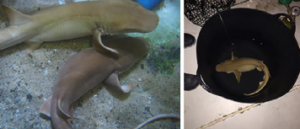Article
First record of recurring reproduction of captive tawny nurse sharks Nebrius ferrugineus. 2019. The fisheries Society of the British Isles. Lewis N. Cocks, Jonathan K.L. Mee, Alex P. Shepherd
Sharks have been kept in public aquariums since the 1860s. Many different species of sharks can be found in aquariums around the world, but nurse sharks are more commonly seen in captivity. Despite their relative abundance in public aquariums, these sharks are classified as vulnerable according to the International Union for the Conservation of Nature (IUCN), and their sub-populations in several areas have already diminished or have been completely destroyed.
Since 2003, an adult population of tawny nurse sharks (N. ferrugineus) originating from the Red Sea has been maintained in an artificial lagoon exhibit at the National Aquarium in Saudi Arabia. These sharks are distributed across the tropical Indo-Pacific region, and are most commonly found in depths between 5 m to 30 m. The lagoon`s system was created in 1998 at a private residence on the central Red Sea coast of Saudi Arabia. It is an open system that utilizes natural seawater drawn from the nearby Red Sea. This artificial lagoon is situated outdoors, and its temperature is controlled by mechanisms that control its variation due solar radiation. The system has perfect water condition for the local sea life.

Welcome to life, baby sharks!!
The perfect water condition makes the lagoon a comfortable environment that houses not only nurse sharks, but also eight other species of sharks, including rays and Red Sea reef fishes. In the National Aquarium, sharks are treated like kings. They are fed six days a week with fresh fish, including squids, tunas, sardines and mackerel. Their rich diet might have helped to avoid deformities in the sharks’ body and increase their chances of survival in the aquarium. On this note, a poor diet could result in abnormal cartilage development and maintenance. A great diet combined with the outdoor environment system, significantly contributed to the reproductive successes of 12 captive tawny nurse sharks.

The first known birthing event of tawny nurse sharks in the lagoon occurred in 2008. Sharks were consistently born in captivity each year until 2015, when the study ended. During this period, scientists made several key observations about nurse sharks life cycle. Scientists found out that each female shark gave birth to one or two sharks per litter. Newborns were measured and their average size is 59.6 cm (2 feet). Scientists also identified the species’ size of first maturity, which is basically the average length that 50% of animals reach at sexual maturity. All the information is scientifically valuable and can contribute to conservation actions for nurse sharks.
Are aquariums a hell or a heaven for sharks?
Keeping sharks in captivity is always challenging. Usually, sharks can`t perform well in captivity, especially high migratory species. While in the wild some species can travel up to 40 miles a day, in aquariums they have no other option besides swimming in circles around their tanks. An example of this was recorded in 2016, when a great white shark died in the Okinawa Churaumi Aquarium after 3 days of captivity.
Some aquariums in the world exhibit sharks in order to promote protection and for educational purposes. However, sharks are extremely sensitive animals. They use between eight and 13 senses. Small tanks and noisy crowds may interfere on their behavior and can confuse the animals. Even simple technical failures can result in death. At SeaWorld, sixteen sharks died after workers waited too long to shut off water being pumped from Mission Bay into the aquariums.
Free sharks are happy sharks!
Sharks in captivity can provide information to scientists about a species` life cycle that are difficult to obtain in natural environment. However, this information can be biased to the captivity environment, once the animals can change their behavior due to stress. Although, information gained in the wild is more accurate and reflects what really happens in their habitat.
Sharks are wild animals and they must be kept in their natural environment. A strategy for effective conservation of these animals must be based in wild habitats. This way, not only sharks would benefit from conservation efforts, but the whole ecosystem.
I graduated from Universidade Federal Rural de Pernambuco in Fishing Engineering. Currently, I a master’s candidate at Hawaii Pacific University. I am very passionate about marine megafauna, especially sharks. When I am not collecting data for my research, I like to be in the ocean surfing and scuba diving.

